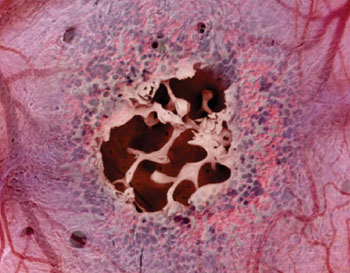Bone Marrow-on-a-Chip Designed to Evaluate New Drugs, Radiation Toxicity
By LabMedica International staff writers
Posted on 26 May 2014
New organ-on-a-chip technology is providing scientists with an important new tool to assess the effects of new drugs and toxic agents on whole bone marrow.Posted on 26 May 2014
The device, nicknamed “bone marrow-on-a-chip,” was developed by scientists from Harvard University’s Wyss Institute for Biologically Inspired Engineering (SEAS; Boston, MA, USA), and reproduces the functions, structure, and cellular composition of bone marrow, a complicated tissue that until now could only be studied intact in living animals, institute researchers reported in the May 4, 2014, online issue of the journal Nature Methods.

Image: Microscopic view of the engineered bone with an opening exposing the internal trabecular bony network, overlaid with colored images of blood cells and a supportive vascular network that fills the open spaces in the bone marrow-on-a-chip (Photo courtesy of James Weaver, Harvard’s Wyss Institute).
Specifically, the device could be used to develop safe and effective approaches to prevent or treat radiation’s deadly effects on bone marrow without resorting to animal testing, a challenge that is being pursued at the Institute with funding support from the US Food & Drug Administration (FDA). In an initial test, the engineered bone marrow, similar to human marrow, shrunk in response to radiation unless a drug known to prevent radiation poisoning was present.
The bone marrow-on-a-chip in the future could also be employed to maintain a cancer patient’s own marrow temporarily while he or she underwent marrow-damaging treatments such as radiation therapy or high-dose chemotherapy. “Bone marrow is an incredibly complex organ that is responsible for producing all of the blood cell types of our body, and our bone marrow chips are able to recapitulate this complexity in its entirety and maintain it in a functional form in vitro,” said Don Ingber, MD, PhD, founding director of the Wyss Institute, a professor of vascular biology at Harvard Medical School and Boston Children’s Hospital, and a professor of bioengineering at the Harvard School of Engineering and Applied Science (SEAS) , and senior author of the study.
Dr. Ingber leads a large effort to develop human organs-on-chips. Up to now, Wyss Institute investigators have constructed lung, heart, kidney, and gut chips that reproduce basic characteristics of organ function, and they have more organs-on-chips in the works. The technology has been recognized internationally for its potential to replace animal testing of new drugs and environmental toxins, and as a new way for scientists to model human disease.
To build organ chips, the researchers have combined multiple types of cells from an organ on a microfluidic chip, while gradually supplying nutrients, removing waste, and applying mechanical forces the tissues would face in the body. But bone marrow is so complicated that they needed a new approach to mimic organ function.
This complexity arises because bone marrow has an essential relationship with bone. Marrow sits inside trabecular bone—a solid-looking type of bone with a porous, honeycombed interior. Some areas are warmer, some cooler; some are oxygen-rich, others oxygen-starved—and the dozen or so cell types each have their own preferred sites. To add complexity, bone marrow cells communicate with each other by secreting and sensing a range of biomolecules, which act locally to tell them whether to live, die, specialize or multiply.
Instead of trying to replicate such a complicated structure cell by cell, the researchers enlisted lab mice to do it. “We figured, why not allow mother nature to help us build what she already knows how to build,” said Catherine S. Spina, an MD, a PhD candidate at Boston University, researcher at the Wyss Institute, and co-lead author of the paper.
Specifically, the researchers packed dried bone powder into an open, ring-shaped mold the size of a coin battery, and implanted the mold under the skin on the animal’s back. After eight weeks, they surgically removed the disk-shaped bone that had formed in the mold and examined it with a specialized computed tomography (CT) imaging scanner. The scan revealed a honeycomb-like structure that looked the same as natural trabecular bone.
When they stained the tissue and examined it under a microscope, the marrow was packed with blood cells, similar to a marrow from a living mouse. Furthermore, when the researchers sorted the bone marrow cells by type and checked their numbers, the combination of different types of blood and immune cells in the modified bone marrow was identical to that in a mouse thighbone.
To maintain the engineered bone marrow outside of a living animal, the researchers surgically removed the engineered bone from mice, then placed it in a microfluidic device that steadily supplied nutrients and removed waste to mimic the circulation the tissue would experience in the body. Marrow in the device remained healthy for up to one week—long enough, typically, to test the toxicity and effectiveness of a new drug.
The device also passed an initial test of its drug-testing capabilities. Similar to marrow from live mice, this engineered marrow was also susceptible to radiation--however, an FDA-approved agent that protects irradiated patients also protects the marrow on the chip. In the future, the researchers could potentially grow human bone marrow in immune-deficient mice. “This could be developed into an easy-to-use screening-based system that’s personalized for individual patients,” said coauthor James Collins, PhD, a Core Faculty member at the Wyss Institute and a professor at Boston University, where he leads the Center of Synthetic Biology.
Bone marrow-on-a-chip could also generate blood cells, which could circulate in an artificial circulatory system to supply a network of other organs-on-chips. The US Defense Agency Advanced Research Projects Agency (DARPA) is also currently providing funds to the Wyss Institute to develop an interconnected network of ten organs on chips to study complex human physiology outside the body.
Related Links:
Harvard University’s Wyss Institute for Biologically Inspired Engineering
Harvard School of Engineering and Applied Science













